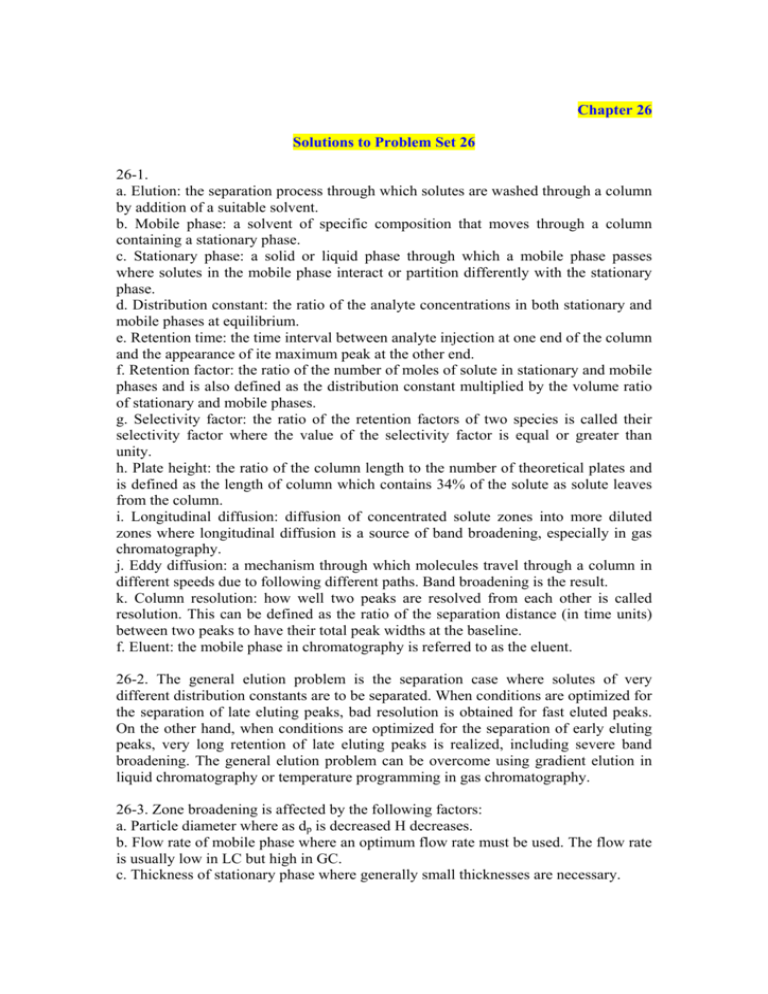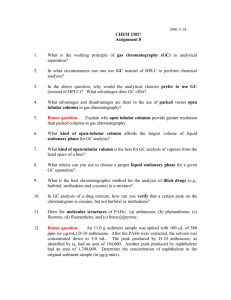26 Chapter Solutions to Problem Set 26 26
advertisement

Chapter 26
Solutions to Problem Set 26
26-1.
a. Elution: the separation process through which solutes are washed through a column
by addition of a suitable solvent.
b. Mobile phase: a solvent of specific composition that moves through a column
containing a stationary phase.
c. Stationary phase: a solid or liquid phase through which a mobile phase passes
where solutes in the mobile phase interact or partition differently with the stationary
phase.
d. Distribution constant: the ratio of the analyte concentrations in both stationary and
mobile phases at equilibrium.
e. Retention time: the time interval between analyte injection at one end of the column
and the appearance of ite maximum peak at the other end.
f. Retention factor: the ratio of the number of moles of solute in stationary and mobile
phases and is also defined as the distribution constant multiplied by the volume ratio
of stationary and mobile phases.
g. Selectivity factor: the ratio of the retention factors of two species is called their
selectivity factor where the value of the selectivity factor is equal or greater than
unity.
h. Plate height: the ratio of the column length to the number of theoretical plates and
is defined as the length of column which contains 34% of the solute as solute leaves
from the column.
i. Longitudinal diffusion: diffusion of concentrated solute zones into more diluted
zones where longitudinal diffusion is a source of band broadening, especially in gas
chromatography.
j. Eddy diffusion: a mechanism through which molecules travel through a column in
different speeds due to following different paths. Band broadening is the result.
k. Column resolution: how well two peaks are resolved from each other is called
resolution. This can be defined as the ratio of the separation distance (in time units)
between two peaks to have their total peak widths at the baseline.
f. Eluent: the mobile phase in chromatography is referred to as the eluent.
26-2. The general elution problem is the separation case where solutes of very
different distribution constants are to be separated. When conditions are optimized for
the separation of late eluting peaks, bad resolution is obtained for fast eluted peaks.
On the other hand, when conditions are optimized for the separation of early eluting
peaks, very long retention of late eluting peaks is realized, including severe band
broadening. The general elution problem can be overcome using gradient elution in
liquid chromatography or temperature programming in gas chromatography.
26-3. Zone broadening is affected by the following factors:
a. Particle diameter where as dp is decreased H decreases.
b. Flow rate of mobile phase where an optimum flow rate must be used. The flow rate
is usually low in LC but high in GC.
c. Thickness of stationary phase where generally small thicknesses are necessary.
d. Diffusion of solute in mobile and stationary phases where in LC a low viscosity
mobile phase is used to increase DM while the opposite is used in GC.
e. Temperature is especially important in GC where high temperatures are usually
used.
26-4. In gas liquid chromatography the mobile phase is a gas while the mobile phase
is a liquid in liquid liquid chromatography.
26-5. The stationary phase is a solid in liquid solid chromatography while a liquid
stationary phase is used in liquid liquid chromatography.
26-6. The selectivity factor for a pair of analytes is affectedby:
a. Mobile phase composition.
b. Nature of stationary phase.
c. Column temperature.
d. Use of special chemical effects like complexing agents, surfactants, ion pairing
reagents, etc.
26-7. The retention factor can be manipulated by the following:
I. In LC:
a. Mobile phase composition.
b. Nature of stationary phase.
c. Use of special chemical effects like complexing agents, surfactants, ion pairing
reagents, etc.
d. Change column length.
II. In GC:
a. Change column length.
b. Nature of stationary phase.
c. Column temperature.
26-8.The number of plates in a chromatographic column can be calculated by finding
the retention time of analyte as well as the width of the peak at half height then
applying the equation:
N = 5.54 {tR/W1/2}2
26-9. Usually, temperature has little effects on separations in liquid chromatography.
However, shorter retention times are realized as temperature is increased in gas
chromatography.
26-10. Longitudinal diffusion terms are the reason for the minima obtained in van
Deemter equation. This term is very important in gas chromatography where DM must
be decreased in gas chromatography to decrease HL. Therefore, high flow rates must
be used. However, the longitudinal term in LC is marginal and increasing the flow
rate will significantly increase band broadening. Thus the minimum in van Deemter
equation occurs at much lower flow rates in LC than GC.
26-11. Gradient elution is a process used in LC whereby the composition of the
mobile phase, or its flow rate, is changed during the separation process to improve
separation characteristics.
26-12. N = 16 {tR/W}2
a. NA = 16(5.4/0.41)2 = 2775.49
b. NB = 16(13.3/1.07)2 = 2472.04
c. NC = 16(14.1/1.16)2 = 2363.97
d. ND= 16(21.6/1.72)2 = 2523.31
b. Mean = (2775.49 + 2472.04 + 2363.97 + 2523.31)/4 = 2533.79
N = 2534 plates
xi
2775
2472
2364
2523
x = 2534
xi - x
241
-62
-170
-11
σ = {(90946)/3}1/2
σ = + 174
c. H = L/N
H = 25.7/2534 = 0.010 cm
26-13. k' = (tR – tM)/tM
a. kA' = (5.4 – 3.1)/3.1 = 0.74
kB' = (13.3 – 3.1)/3.1 = 3.3
kC' = (14.1 – 3.1)/3.1 = 3.5
kD' = (21.6 – 3.1)/3.1 = 6.0
b. the distribution constant, k = k' VM/VS
KA = 0.74 * 1.37/0.164 = 6.2
KB = 3.3 * 1.37/0.164 = 26
KC = 3.5 * 1.37/0.164 = 29
KD = 6.0 * 1.37/0.164 = 50
26-14.
a. Resolution = 2(tRC – tRB)/(WC + WB)
R = 2(14.1-13.3)/(1.16+1.07) = 0.72
b.The selectivity factor, α = kC'/kB
α= 3.5/3.3 = 1.06
R1/R2 = {L1/L2}1/2
0.72/1.5 = {25.7/L2}1/2
L2 = 112 cm
(xi - x)2
58081
3844
28900
121
Σ (xi - x)2 = 90946
d. The time required to separate B from C in a 25.7 cm column is 14.1 min. When the
column length is increased from 25.7 to 112 cm the retention time increases in the
same proportion:
tR1/tR2 = L1/L2
14.1/tR2 = 25.7/111.5
tR2 = 61 min
26-15.
a. Resolution = 2(tRD – tRC)/(WC + WD)
R = 2(21.6 – 14.1)/(1.16+1.72) = 5.21
R1/R2 = {L1/L2}1/2
5.21/1.5 = {25.7/L2}1/2
L2 = 2.1 cm
26-16. a.
N = 5.54 {tR/W1/2}2
a. NMCHexane = 5.54(10.0/0.76)2 = 959
b. NMCHexene = 5.54(10.9/0.82)2 = 979
c. NToluene = 5.54(13.4/1.06)2 = 885
Mean = (959 + 979 + 885)/3 = 941
N = 941 plates
b.
xi
959
979
885
x = 941
xi - x
18
38
56
(xi - x)2
324
1444
3136
Σ (xi - x)2 = 4904
σ = {(4904)/2}1/2
σ = + 50
c. H = L/N
H = 40/941 = 0.043 cm
26-17. N = 5.54 {tR/W1/2}2 and N = 16 {tR/W}2
5.54 {tR/W1/2}2 = 16 {tR/W}2
2.354 tR/W1/2 = 4 tR/W
W = 1.70 W1/2
a. Resolution = 2(tR,MCHexene – tR, MCHexane)/1.7(W1/2, MCHexene + W1/2, MCHexane)
R = 2(10.9 – 10.0)/ 1.7(0.82+0.76) = 0.67
b. Resolution = 2(tR, Toluene – tR, MCHexene)/1.7(W1/2, Toluene + W1/2, MCHexene)
R = 2(13.4 – 10.9)/1.7(0.82+1.06) = 1.56
c. Resolution = 2(tR, Toluene – tR, MCHexane)/1.7(W1/2, Toluene + W1/2, MCHexane)
R = 2(13.4 – 10.0)/1.7(0.76 +1.06) = 2.20
26-18. a.
R1/R2 = {N1/N2}1/2
0.67/1.5 = {941/N2}1/2
N2 = 4717 plates
b. R1/R2 = {L1/L2}1/2
0.67/1.5 = {40/L2}1/2
L2 = 200 cm
c. tR1/tR2 = (R1/R2)2
10.9/tR2 = (0.67/1.5)2
tR2 = 54.6 min
26-19. a.
k' = (tR – tM)/tM
kMCHexane' = (10.0 – 1.9)/1.9 = 4.3
kMCHexene' = (10.9 – 1.9)/1.9 = 4.7
kToluene' = (13.4 – 1.9)/1.9 = 6.1
b. the distribution constant, k = k' VM/VS
KMCHexane = 4.3 * 62.6/19.6 = 13.7
KMCHexene = 4.7 * 62.6/19.6 = 15.0
KToluene = 6.1* 62.6/19.6 = 19.5
c. The selectivity factor, α = kMCHexene'/kMCHexane'
α= 4.7/4.3 = 1.09
d. . The selectivity factor, α = kToluene'/kMCHexene'
α= 6.1/4.7 = 1.30
26-20. Zone broadening is affected by the following factors:
a. Particle diameter where as dp is decreased H decreases.
b. Flow rate of mobile phase where an optimum flow rate must be used. The flow rate
is usually low in LC but high in GC.
c. Thickness of stationary phase where generally small thicknesses are necessary.
d. Diffusion of solute in mobile and stationary phases where in LC a low viscosity
mobile phase is used to increase DM while the opposite is used in GC.
e. Temperature is especially important in GC where high temperatures are usually
used.
Zone separation between a pair of analytes is affected by:
a. Mobile phase composition.
b. Nature of stationary phase.
c. Column temperature.
d. Use of special chemical effects like complexing agents, surfactants, ion pairing
reagents, etc.
e. Increase column length.
26-21. Slow sample introduction (injection) leads to serious band broadening.
26-22. a. k' = k VS/VM
kM' = 6.01 * 0.422 = 2.54
kN' = 6.20 * 0.422 = 2.62
b. α = kN'/kM'
α= 2.62/2.54 = 1.03
c. R = (N1/2/4) {KN'/(1+kN')}{(α-1)/α)
1.5 = (N1/2/4) (2.62/3.62)(0.03/1.03)
N = 8.1x104 plates
d. H = L/N
L = NH = 8.1x104 * 2.2x10-3 = 178 cm
e. tR,N = (16 R2 H/u) ){(α)/(α − 1)}2 (1+KN')3/(kN')2
tR,N = 16 (1.5)2 2.2x10-3/7.1 (1.03/0.03)2 (3.62)3/(2.62)2
tR,N = 91 min
26-23. Same as 26-22
26-24.
Compound
Methyl acetate
Methyl
propionate
Methyl nbutyrate
Peak Area,
A
17.6
44.7
Response
Factor, F
0.65
0.83
A/F
27.1
53.9
Percentage
(A/F)/Σ
23.6
47.0
31.1
0.92
33.8
29.4
Σ 114.8
26-25.
Compound
Dehydroepiandrosterone
Estradiol
Estrone
Testosterone
Estriol
Peak
Area, A
27.6
32.4
47.1
40.6
27.3
Response
Factor, F
0.70
0.72
0.75
0.73
0.78
A/F
39.4
45.0
62.8
55.6
35.0
Σ = 237.8
Percentage
(A/F)/Σ
16.6
18.9
26.4
23.4
14.7




